U.S. colleges that have employed the most Nobel Prize-winning professors
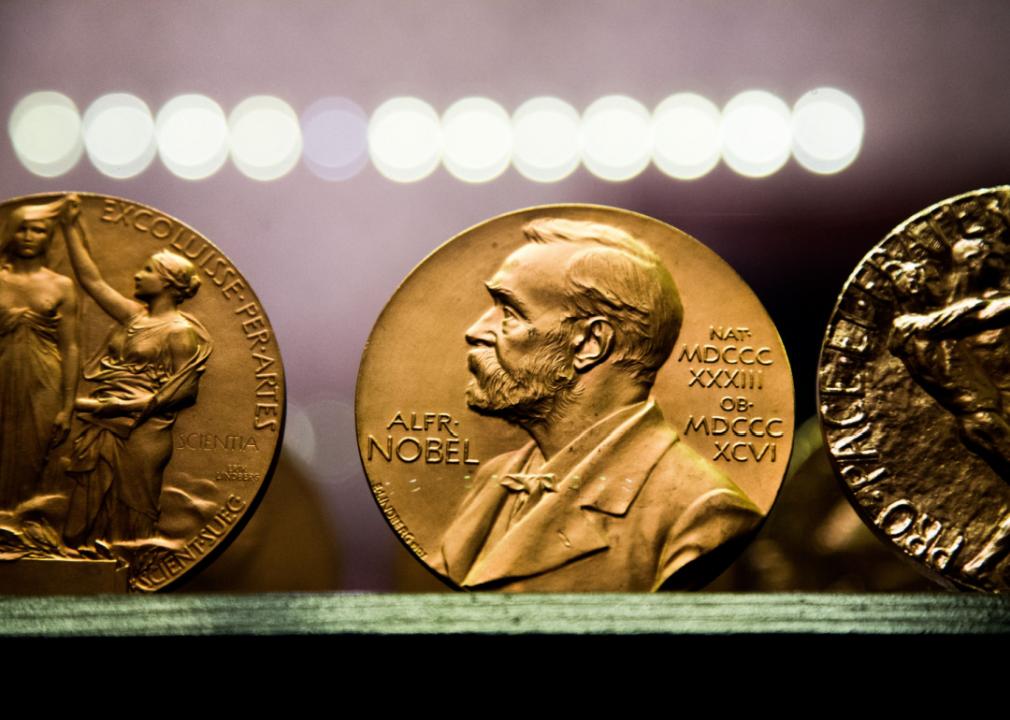
Jeppe Gustafsson // Shutterstock
U.S. colleges that have employed the most Nobel Prize-winning professors
Nobel medals on display at Björkborn’s mansion.
The Nobel Prize is considered one of the greatest life achievements, as has been the case for the last century. The international prize is bestowed upon individuals who have made far-reaching contributions to human understanding. Many recipients are professors at renowned universities, including many in the U.S.
But some schools have had far more success than others.
The Nobel Prize was a creation of Alfred Nobel, a storied inventor responsible for creating dynamite. After Nobel’s death in 1896, through his last will and testament, the public learned he left behind a large sum of money to fund awards in his name for the most influential organizations and individual contributors to science, the arts, and world peace.
Today, the award is associated with many of the most revered figures around the world, deemed Nobel laureates. Recipients include Martin Luther King Jr., Mother Teresa, Albert Einstein, Marie Curie, and Theodore Roosevelt.
The colleges that employ these honorees can add significant value for students who may have the opportunity to learn from them and even work alongside them in a research capacity. They also offer the laureates abundant resources to continue their research and work on things like discoveries about the physics of our galaxy, combating infectious diseases, and eliminating poverty.
Study.com identified the 10 U.S. universities that have employed the most Nobel Prize winners, tallied according to the awardees’ organization affiliations at the time of the award. Counts include Nobel laureates in physics, chemistry and physiology/medicine, economic sciences, and peace efforts.
The universities that employ Nobel recipients are not always the same schools where those recipients studied for their degrees. The employment of these influential thinkers could say as much about the donor base of a university as it does the quality of education there. Many of the universities with the largest number of staff who go on to become laureates also benefit from the biggest endowments.
![]()

Winston Tan // Shutterstock
#10. Yale University
Yale’s central campus seen from Harkness Tower.
– Location: New Haven, Connecticut
– Number of Nobel Prize affiliations: 9
– Note: Includes an award to the Yale University School of Medicine.
The Nobel laureates working at Yale include experts in thermodynamics, biology, physiology, and economic sciences and market behaviors. William D. Nordhaus is the faculty member most recently honored with the award. The Nobel Prize organization recognized him for his work integrating climate change into macroeconomic analysis.

Jay Yuan // Shutterstock
#9. Princeton University
A couple of students walk on a mostly empty Princeton campus.
– Location: Princeton, New Jersey
– Number of Nobel Prize affiliations: 17
Princeton has employed nine winners of the Nobel Prize in physics, six in economic sciences, one for physiology or medicine, and another for chemistry. In 2021, Princeton professor Syukuro Manabe was honored with the Nobel Prize in Physics for his modeling of Earth’s climate and developing reliable predictions of global warming, according to the organization.
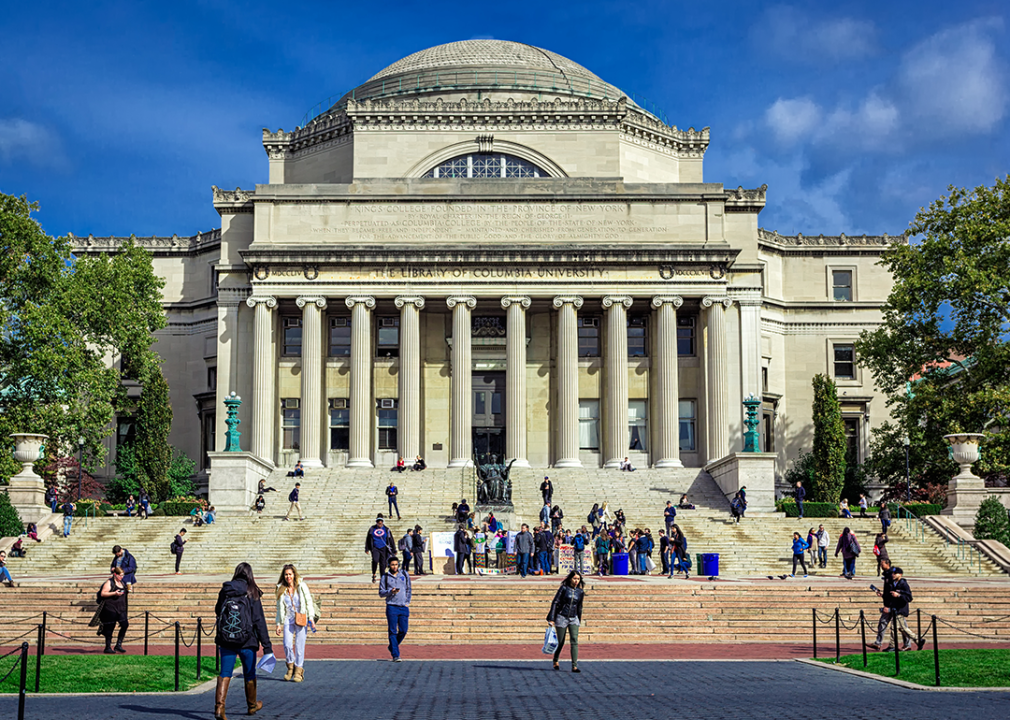
Dmitrii Sakharov // Shutterstock
#7. Columbia University (tie)
Students walking near the Columbia Library steps.
– Location: New York, New York
– Number of Nobel Prize affiliations: 19
– Note: Includes an award won in conjunction with Bellevue Hospital.
The largest share of Columbia University’s on-staff laureates received their Nobel Prize for physics. Its most recent staffer to be honored was Louis Brus in 2023, who received the prize for discovering “quantum dots.” The discovery marked a significant advancement for nanotechnology. Quantum dots are tiny semiconductors that can detect cancer and other cellular phenomena.

Mariusz Lopusiewicz // Shutterstock
#7. Rockefeller University (tie)
Rockefeller University and the East River in New York City.
– Location: New York, New York
– Number of Nobel Prize affiliations: 19
– Note: Includes awards won under its historical name, Rockefeller Institute for Medical Research.
At Rockefeller University, the most recent award was bestowed on professor Charles M. Rice for finding a cure for hepatitis C. Rice is now working with the university to study the hepatitis B virus in its virology and infectious disease lab. The university has mostly employed laureates honored with a Nobel in physiology or medicine, including for studies related to the nervous system, antibodies, and circadian rhythm.

Ken Wolter // Shutterstock
#6. California Institute of Technology
Main campus entry to CalTech.
– Location: Pasadena, CA
– Number of Nobel Prize affiliations: 20
CalTech has proven a powerhouse for students looking to brush shoulders with some of the brightest minds in science. The laureates it has employed have been recognized for studying gravitational waves, genetic control of embryos, and other aspects of quantum physics. CalTech also employed Linus Pauling, a two-time Nobel recipient recognized for his achievements in chemistry as well as for advocating against the nuclear arms race of the mid-20th century.
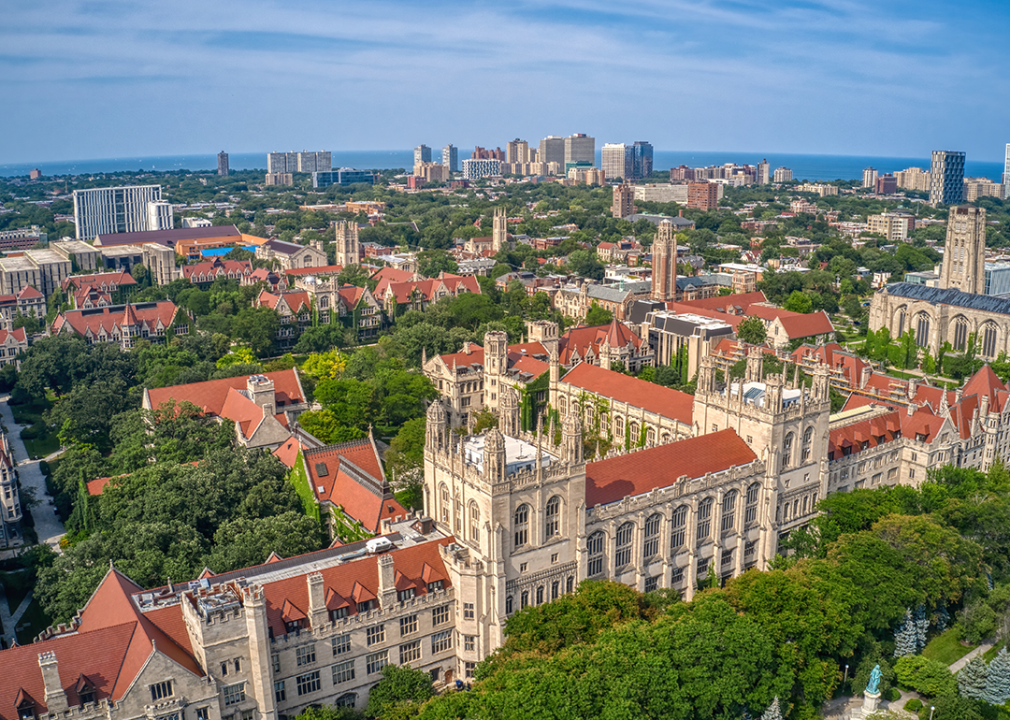
Jacob Boomsma // Shutterstock
#5. University of Chicago
An aerial view of the University of Chicago campus.
– Location: Chicago, Illinois
– Number of Nobel Prize affiliations: 21
– Note: Includes an award to the Ben May Laboratory for Cancer Research and the Enrico Fermi Institute.
Nearly all of the University of Chicago’s laureates employed over the years have received their Nobel Prize for making contributions to economic sciences. Most recently, distinguished professor Douglas W. Diamond was recognized alongside former Fed chairman Ben Bernanke for researching the relationship between banks and financial crises. Bernanke was Fed chair at the time of the Great Recession.
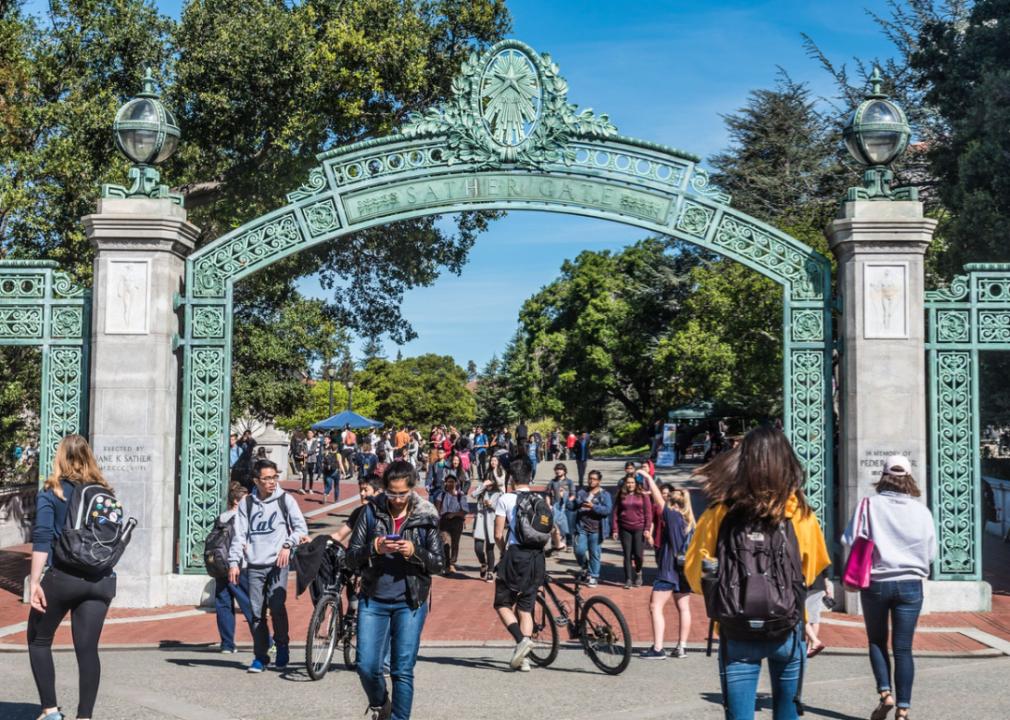
David A Litman // Shutterstock
#4. University of California, Berkeley
Students pass through Sather Gate at UCB.
– Location: Berkeley, California
– Number of Nobel Prize affiliations: 22
– Note: Includes an award to the Lawrence Berkeley National Laboratory, operated by the University of California.
The University of California, Berkeley is a major research institution that’s employed a number of Nobel recipients, many of whom earned their awards for work in physics and economic sciences. They include Reinhard Genzel, who received the Nobel Prize in physics in 2020 for his work discovering the existence of a supermassive black hole at the center of the Milky Way galaxy. Genzel is currently working with a research team at the university to determine whether there is a black hole at the center of every galaxy.
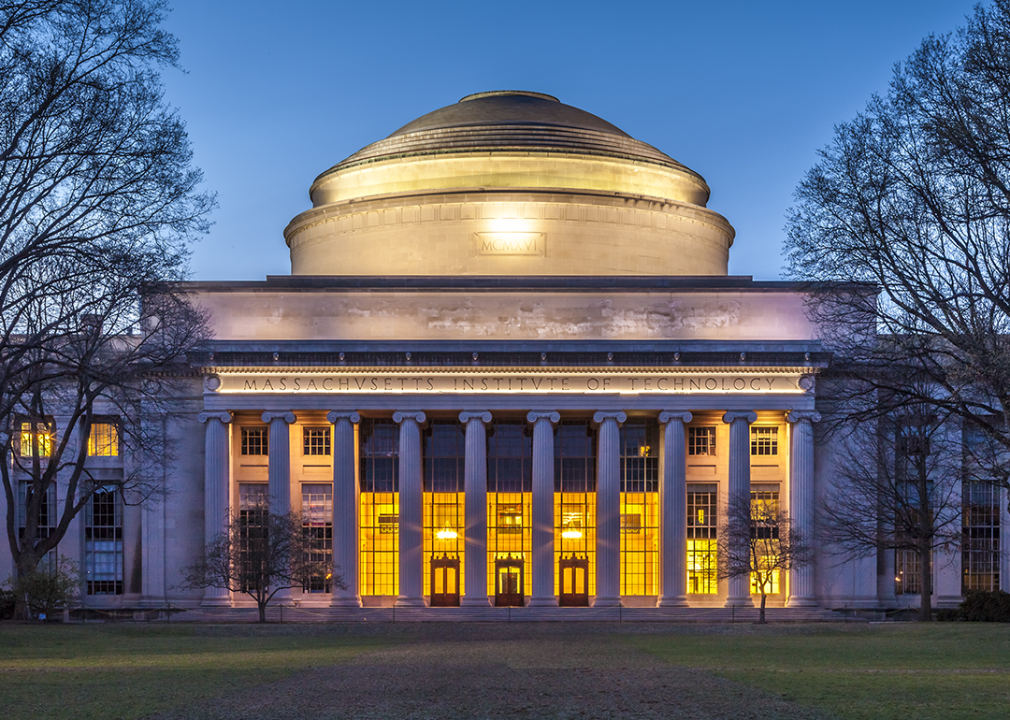
Marcio Jose Bastos Silva // Shutterstock
#3. Massachusetts Institute of Technology
Neoclassical building on the MIT campus.
– Location: Cambridge, Massachusetts
– Number of Nobel Prize affiliations: 24
– Note: Includes an award to MIT’s Center for Cancer Research, now called the Koch Institute for Integrative Cancer Research.
Colloquially known as MIT, the Massachusetts Institute of Technology is renowned for its contributions to science. Despite its common association with physics and chemistry, MIT has also employed eight Nobel recipients who contributed to economics. French American economist and professor Esther Duflo recieved the Nobel in economic sciences for her experimental approach to alleviating global poverty.
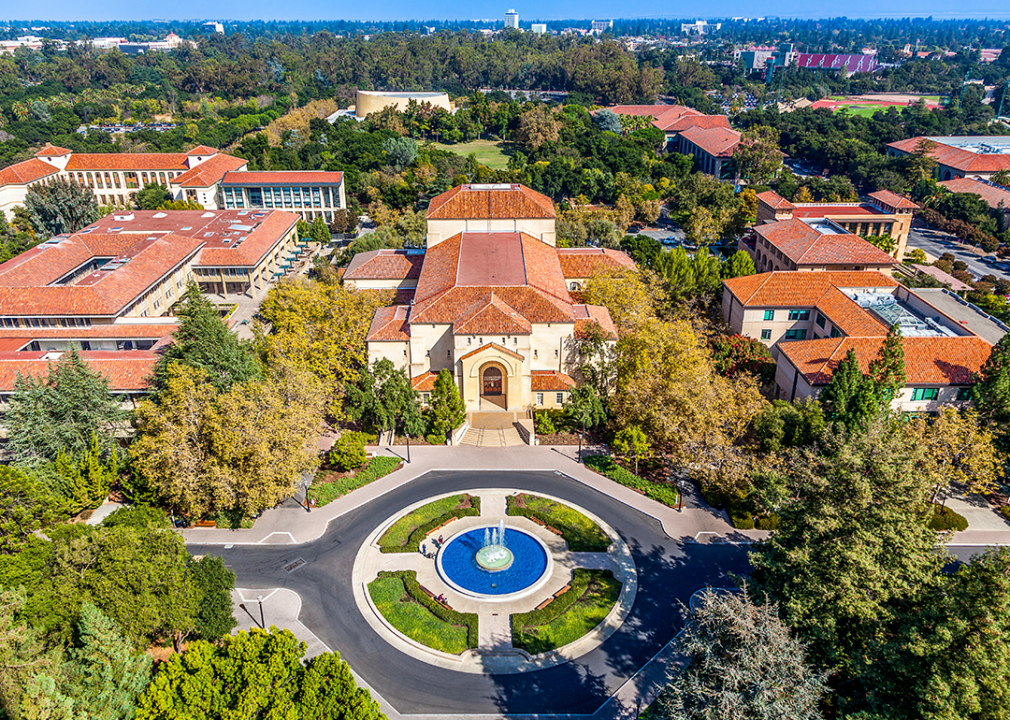
turtix // Shutterstock
#2. Stanford University
An aerial view of Stanford campus.
– Location: Stanford, California
– Number of Nobel Prize affiliations: 26
– Note: Includes awards to the university’s medical school and the Stanford-operated SLAC National Accelerator Laboratory.
Laureates working in the halls of Stanford and its related institutions have received credit for their discoveries of new subatomic particles, methods for analyzing atoms with lasers, studies of DNA and RNA, and models for risk-reward analysis in investing. Stanford’s laureates have mostly been recognized in the chemistry and physics fields. The university operates a Department of Energy lab in Silicon Valley called the SLAC that regularly makes new scientific contributions.

Joseph Sohm // Shutterstock
#1. Harvard University
An aerial view of the Hartford campus.
– Location: Cambridge, Massachusetts
– Number of Nobel Prize affiliations: 39
– Note: Includes awards to Harvard Business School, Harvard Medical School, and Harvard’s Biological Laboratories and Lyman Laboratory.
Harvard University not only has the largest endowment of any college in the U.S. but also the most decorated staff in terms of Nobel Prizes. Harvard is well known for its business and medical programs, which have hired numerous recipients of the Nobel Prize for physiology, medicine, and economic sciences. In 2023, professor Claudia Goldin received a Nobel Prize in economics for her studies of women in the workforce. She was the third woman to receive the prize and the first to receive it for her work alone.
Story editing by Ashleigh Graf. Copy editing by Kristen Wegrzyn.
This story originally appeared on Study.com and was produced and
distributed in partnership with Stacker Studio.